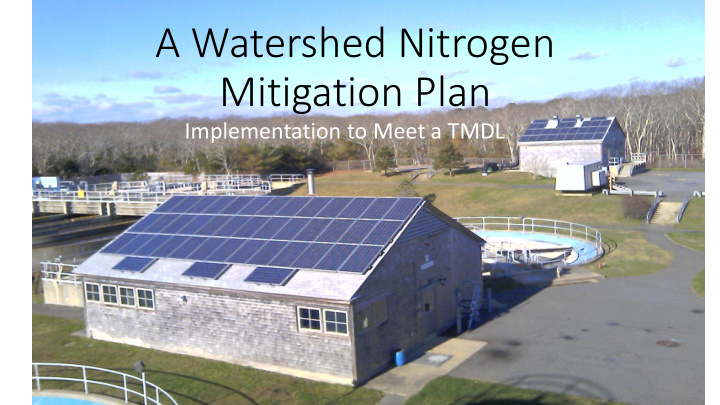



A Watershed Nitrogen Mitigation Plan Implementation to Meet a TMDL
Edgartown Great Pond and Watershed
Edgartown Great Pond MVC Recommendations 1. Sewer in watershed in Pond impacted by development- suitable areas algae and loss of eelgrass, 2. Regular pond openings and decline of shellfish. dredging Town agrees to help fund MEP 3. Re-establishment of study to be issued in 2004. shellfish and historic herring runs 1999 Martha's Vineyard 4. Fertilizer limits, lawn limits, Commission study leads to shoreline setbacks. Special condition (g) added to 5. Alternative systems in Discharge Permit of 2004. more sparsely settled areas
Nitrogen Loading Factors to Edgartown Great Pond
Sp Specia ial l Condit itio ion (g (g) file filed with ith DEP 1/2 /26/2004 • 1. Wastewater Commission agrees to set an Operational Goal of <5 mg/L Total Nitrogen • 2. Commission agrees to retain the plant capacity to remove 300 septics from the watershed.
SEPTICS, SEWER, AND POND: NITROGEN (N) LOADING IN SCALES OF 10. SEPTIC TITLE V AND CESSPOOLS INFLUENT COMES IN AT N OF 35 MG/L. SYSTEM EMITS N AT 35 MG. PER LITER (or 35 parts per million) (A nitrogen reducing Alternative System may reduce this to 15 MG/L if functioning properly.) WASTEWATER TREATMENT — INFLUENT COMES IN AT N OF 35 MG/L. The effluent is discharged after treatment to ground sand beds AT <3 MG/L. THE TARGET N FOR THE EDGARTOWN GREAT POND IS 0.35 MG/L.
Facility Watershed Projec ject 1. Initial mitigation: 60 BR/15 Llewellyn lots/6,600 gpd. These were the A/I systems. 2. Island Grove: 600 BR/150 lots/66,000 gpd. lsland 3. Road to the Plains: 540 BR/135 lots/ 59,400 gpd. Grove 4. Llewellyn Way: 100 BR/25 lots/11,000 gpd 5. Town project: 40 BR/10 lots/4,400 gpd. Total: 1340 BR/335 lots/147,400 gpd. THESE ARE ALL LOW PRESSURE GRINDER PUMPS........
The Low Pressure Sewer Option in Retrospect • 1. The Good: initial cost, minimal disruption, gravity issues in flat glacial outwash plain avoided • 2. The Problematic: the case for the Continuity of Service argument. • 3. The Bad: eventual Capital Replacement cost of pumps.
Im Imple lementatio ion • 1. Dredging to increase circulation, and regular pond openings. • 2. Oyster program, restoration of Crackatuxet herring run. • 3. New Fertilizer Regulations. • 4. the Alternative systems option: These systems have not proven themselves effective in seasonally occupied residences. Well maintained A/I systems presently reduce N from 35 mg/L to 15 mg/L “Parcels in thinly settled areas should be contemplated for Alternative Systems, as much to have "skin in the game" with other residents as for their more limited mitigation potential.”
Plan feature Effects Pressure Sewer: Low cost and flexibility. Initial low cost. Basic maintenance by wastewater staff Otherwise, maintenance, service and should be contemplated and reflected eventual Capital Replacement Cost-to in overall rates-the Continuity of Service be borne by who? Argument. The Continuity of Service Argument: Sewer customers, gravity and pressure, Rates for sewer users to encompass are all paying at similar rates and pump Capital Replacement-or fair warning to customers should be able to expect the owners of the consequences of same Continuity of Service as gravity substantial replacement cost in the customers. If your pump fails, the future. Wastewater Dept. will replace it with a working one immediately, no charge.
Sources: • "Edgartown Great Pond: Nutrient Loading and Recommended Management Program, 1996-1998" Martha's Vineyard Commission, William M. Wilcox et al. 1999 • "Nutrient Management Study Report Pursuant to Special Condition I(A)(g) of Groundwater Discharge Permit SE #2-24" Edgartown Wastewater Commission. 1999 • "Linked Watershed-Embayment Model to Determine Critical Nitrogen Loading Threshold for the Edgartown Great Pond System, Edgartown, MA." Mass. Estuaries Project, SMAST, MADEP. Final Report, December 2008. • "Ownership of Pressure Sewer Systems "the only thing we have to fear is fear itself" Henry S. Albro, NEWEA, January 29, 2014
QUESTIONS???
Recommend
More recommend